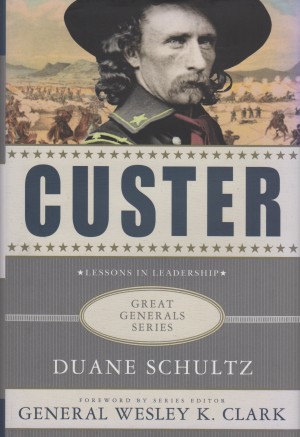
Custer: Lessons in Leadership by Duane Schultz (2010. Palgrave. ISBN 9780230617087)
General Wesley Clark provides the forward in this tightly written snapshot biography of the military career of General George Armstrong Custer. From the beginning, it’s clear that this volume isn’t a book dedicated to preserving the Custer legend (boy hero, gallant cavalry officer, loving husband) in that Schultz quickly unfurls the traits buried within the boy general (impetuousness, disdain for following orders, unreasonable decisiveness) that end up foretelling the bleached bones of Custer and his men on a hilly battlefield next to the Little Big Horn River. But Schultz is careful to balance the ending, a scene every male over the age of fifty knows by heart from movies, film, and past books on the topic (Son of the Morning Star being the best and most comprehensive that I’m acquainted with) knows by rote, with the sometimes diminished and shoved-to-the-back of the narrative tale of Custer the Civil War hero. Yes, hero. Schultz makes a good case that without George Armstrong Custer at General Phillip Sheridan’s side (or the side of Custer’s prior commanders during the war) battles that were Union victories or at the very least, not defeats, may have turned disastrous but for Custer’s famed charges into the heat of battle at the head of his galloping column.
Simplified, the author takes that imagery, the boy general astride his steed, long locks flowing, red scarf whipping in the hot air, saber raised, charging at either entrenched Rebel infantry or wheeling his horse soldiers headlong into Jeb Stuart’s Confederate horsemen, and explains, in very ordinary and understandable terms how the brazen courage that stood Custer so well in a conventional war became his undoing when fighting the Sioux and the Cheyenne. Simply put, there was, at the Little Big Horn, in addition to ill conceived tactical decisions that split the 7th Cavalry and diminished Custer’s chances, a very strategic difference between attacking a defined enemy line and dealing with guerrilla fighters who’ve lived their entire lives on the back of horses.
I would have raised my appreciation of this modest effort to a 4 and 1/2 star rating if the author had spend more time comparing Custer’s end and his failure to recognize the changed circumstances of his foe with similar failures by the American military in Vietnam or the current situations confronting our military in Iraq and Afghanistan. More enlightenment and commentary in that regard would have been very welcome by this reader.
Still, in the end, Schultz’s effort, laying out the differences in the types of conflicts Custer found himself in, is well worth the effort this slim volume requires.
4 stars out of 5.
Peace.
Mark


